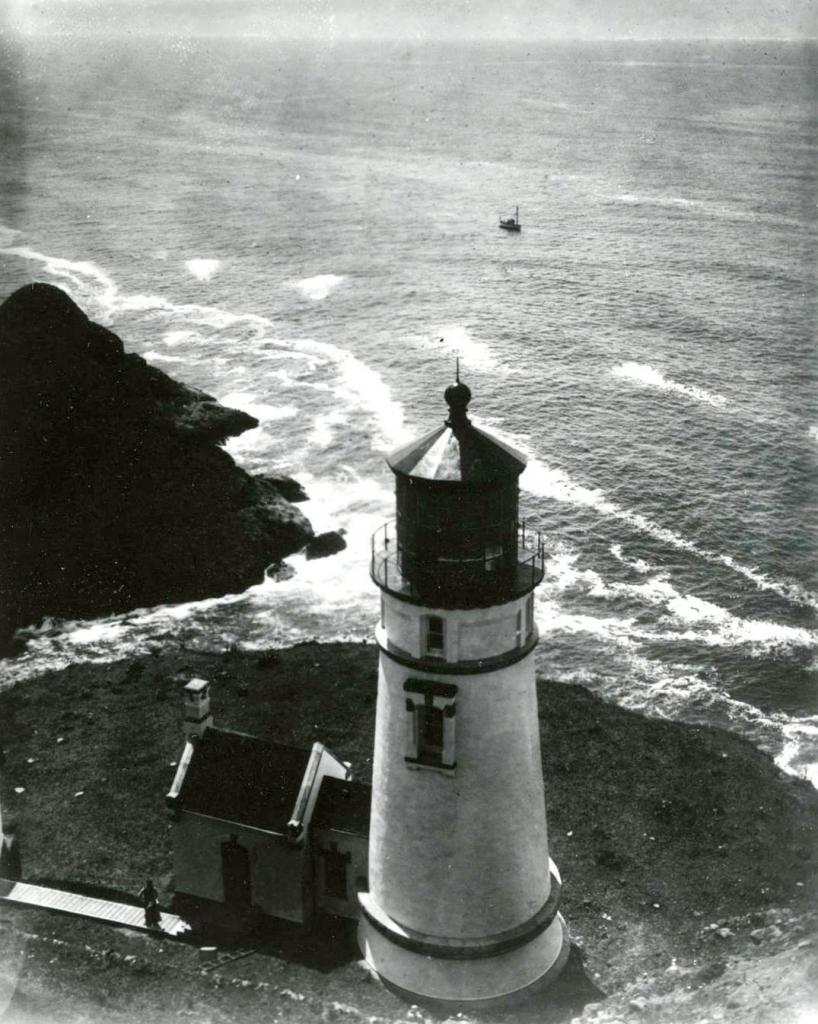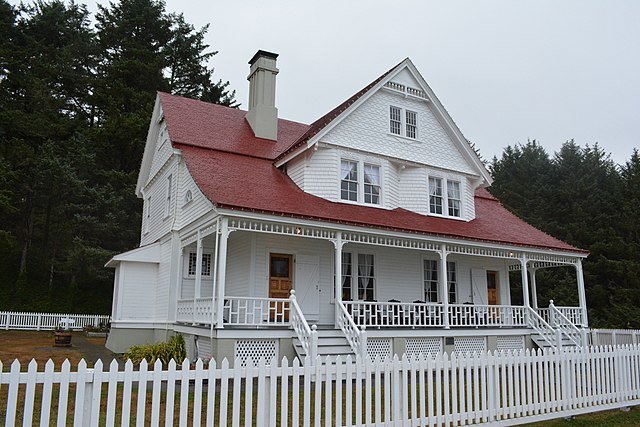
In a PBS special called Legendary Lighthouses, the Heceta Head Lighthouse is referred to as a haunted lighthouse—stating that nearly everyone who has stayed at the lighthouse since the 1950s has experienced paranormal activity. These experiences include things like disembodied screams, items moving or disappear and the reappearing on their own, as well as the shadow of an old woman’s ghost in an attic window. Along with the older woman, it is said that her daughter also haunts this scenic lighthouse.
The History of the Heceta Head Lighthouse
This Queen Anne styled cottage with a red roof overlooks the rocky cliffs and violent waves of the Pacific Ocean and has done so for more than a century. Originally built in 1894, when the lamp was first lit, to the early 1960s, the men who kept the lighthouse running, and their families called this cottage home. During World War II it served as military barracks and was used as a satellite campus for Lane Community College in Eugene from 1970 to 1995. Since 1995, it has been run as a bed and breakfast with room enough to fit fifteen guests comfortably.
Ghostly Experiences at the Lighthouse Keeper’s Cottage

Some of the experiences that have occurred on the premises have been the apparition of a gray-haired woman who appears wearing a late Victorian-era dress; a wispy gray figure has also appeared floating down the hallway. The sounds of sweeping and furniture being moved occur at night and they come from the locked and otherwise unoccupied attic. These occurrences in the lighthouse keeper’s cottage have given this location the reputation of being one of the most haunted places on the West Coast.
For the last four decades, the main apparition—or presence—has been known as Rue, ever since a group of the Lane Community College students broke out their Ouija Board and began to ask questions. Apparently the board spelled out, “R-U-E,” and the name stuck. While “[Rue] doesn’t ever do anything scary or harmful or threatening,” current manager Anderson reports, “it’s more like she’s watching over the place. Watching the house and looking for her daughter.”
Anderson has heard many versions of many stories over the years that she has managed the property, to the point where she wonders if they even know the truth, and says that “it’s just [their] version [of the story].” The only story that they do endorse as the truth is the theory that Rue was the wife of one of the lighthouse keepers, but records can’t confirm that due to the fact that the wives and children of the keepers were never documented. Anderson believes that Rue had two daughters and that one of them had drowned—they are uncertain whether she drowned in the ocean or in a cistern, but that there is an unmarked grave up on the hillside that had been long left undisturbed and consequently was overgrown.
Although Rue left the Heceta Head Cottage after her daughter died, it is said that she came back after her own death to look for her daughter. When checking into the bed and breakfast, there are many guests that request the Victoria room, where the keepers of the lighthouse and their wives were said to have slept. Others are drawn to the Cape Cove Room, which contains a closet that houses the stairs leading up to the locked attic. Still other guests prefer not to know at all.
Possibly the most frightening encounter with Rue that was ever reported appeared in the Siuslaw News in 1975—a workman was cleaning one of the windows in the attic when he noticed an odd reflection in the glass. When she turned to see what was behind him, he saw the apparition of an elderly woman wearing a late-Victorian style gown—he fled the house and didn’t return to the cottage for several days and refused to ever go into the attic again. Even when he accidentally broke one of the attic windows, he opted instead to repair the window from the outside and the broken glass was left on the attic floor. That same night, the caretakers of the house were woken up to the sounds of scraping sounds in the attic and reported that it sounded as if someone was sweeping up broken glass, but they had not yet been told about the broken window. The next morning when they went to investigate, they found that the glass had been swept into a neat pile.
Other stories include one from a guest when sleeping in the Cape Cove room, she was awakened at 4:30 in the morning to what felt like a presence climbing into bed beside her and staying for a couple of hours. She said she felt concerned about the experience, but she was unharmed and in an odd way felt honored that she had the opportunity to experience it. Despite the lack of truly negative experiences, the manager of the bed and breakfast, Anderson, refuses to spend the night there anymore.
One of her employees, a housekeeper and food server named Beth Mozzachio, said she often feels a presence while she’s working and specifically reported making the bed and then noticing a depression has formed, as if someone recently sat there. Mazzachio knows that if she ever saw an apparition of Rue that she would be terrified, but believes that because she takes care of the inn and makes it look nice that Rue doesn’t bother her much.
The Anna Byrne Chronicles: Chapter 01 – The Haunting of Heceta Head
We’ve discussed the Heceta Head Lighthouse before in our Encyclopedia of Supernatural Horror, where we aimed to discuss the facts of the location–in this article we’ve tried to go a bit further with witness experiences. We have even created an original horror fiction where our character visits Heceta Head–so check out The Anna Byrne Chronicles: Chapter 01 – The Haunting of Heceta Head.

Georgia-based author and artist, Mary has been a horror aficionado since the mid-2000s. Originally a hobby artist and writer, she found her niche in the horror industry in late 2019 and hasn’t looked back since. Mary’s evolution into a horror expert allowed her to express herself truly for the first time in her life. Now, she prides herself on indulging in the stuff of nightmares.
Mary also moonlights as a content creator across multiple social media platforms—breaking down horror tropes on YouTube, as well as playing horror games and broadcasting live digital art sessions on Twitch.
